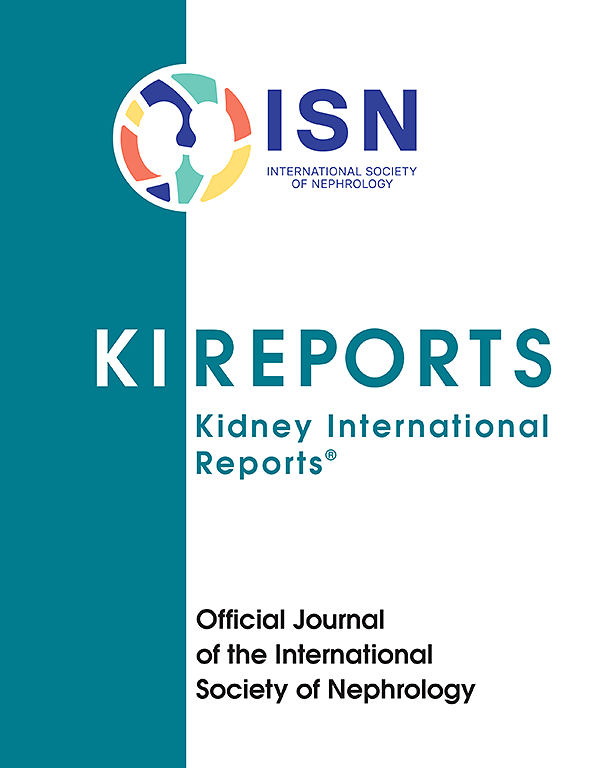Randomized Trial of Lower-Dose Roxadustat Efficacy and Safety in Non–Dialysis-Dependent CKD-Associated Anemia
IF 5.7
2区 医学
Q1 UROLOGY & NEPHROLOGY
引用次数: 0
Abstract
Introduction
Different starting doses of roxadustat are used for treating anemia in chronic kidney disease (CKD). We tested the noninferiority of weight-based lower starting dose compared with standard starting dose roxadustat for anemia in stage 3 to 5 CKD without dialysis.
Methods
Patients were randomized (1:1) and stratified by CKD stage to receive weight-based standard (< 60 kg: 70 mg 3 times per week [TIW]; ≥ 60 kg: 100 mg TIW) or 1-step-lower (< 60 kg: 50 mg TIW; ≥ 60 kg: 70 mg TIW) roxadustat starting dose for 16 weeks. The primary endpoint was mean hemoglobin change from baseline over weeks 12 to 16. The secondary endpoints included the proportion achieving hemoglobin 100 to 120 g/l, hemoglobin variability, and rescue therapy.
Results
Overall, 254 patients were randomized. The mean (SD) baseline hemoglobin was 89.88 (6.90) g/l. Most patients had stage 4 (39.0%) or stage 5 (40.2%) CKD. Mean hemoglobin increased from baseline at weeks 12 to 16 (lower: 21.57 g/l; standard: 26.35 g/l), but noninferiority was not met. A comparable proportion achieved hemoglobin of 100 to 120 g/l (lower: 46.0%; standard: 47.2%). The hemoglobin increase was comparable in CKD stage 3 to 4, but less with the lower dose in CKD stage 5 (17.28 vs. 26.71 g/l). The lower dose exhibited a lower hemoglobin rate of change (lower: 2.917; standard: 3.376) and less drug exposure. Drug-related adverse event rates were comparable.
Conclusion
The proportion of patients who achieved the hemoglobin target was comparable between the doses. The lower starting dose had less hemoglobin fluctuation and is recommended for stage 3 to 4 CKD.

低剂量罗沙司他治疗非透析依赖性ckd相关性贫血的有效性和安全性的随机试验
不同起始剂量的罗沙司他用于治疗慢性肾病(CKD)贫血。我们测试了以体重为基础的较低起始剂量与标准起始剂量的罗沙司他治疗无透析的3 - 5期CKD贫血的非劣效性。方法患者按CKD分期(1:1)随机分组,接受基于体重的标准治疗(<;60公斤:70毫克,每周3次[TIW];≥60kg: 100mg TIW)或更低一级(<;60 kg: 50 mg TIW;≥60 kg: 70 mg TIW)罗沙他他起始剂量为16周。主要终点是12周至16周的平均血红蛋白变化。次要终点包括血红蛋白达到100至120 g/l的比例、血红蛋白变异性和抢救治疗。结果共纳入254例患者。平均(SD)基线血红蛋白为89.88 (6.90)g/l。大多数患者为4期(39.0%)或5期(40.2%)CKD。平均血红蛋白在第12周至第16周较基线升高(较低:21.57 g/l;标准:26.35 g/l),但不符合非劣效性。相当比例的血红蛋白达到100 - 120 g/l(低:46.0%;标准:47.2%)。在CKD 3期和4期,血红蛋白的增加是相当的,但在CKD 5期,低剂量的血红蛋白增加较少(17.28 g/l vs. 26.71 g/l)。剂量越小,血红蛋白变化率越低(低:2.917;标准:3.376)和较少的药物暴露。药物相关不良事件发生率具有可比性。结论两种剂量间达到血红蛋白指标的患者比例具有可比性。较低的起始剂量有较少的血红蛋白波动,推荐用于3至4期CKD。
本文章由计算机程序翻译,如有差异,请以英文原文为准。
求助全文
约1分钟内获得全文
求助全文
来源期刊

Kidney International Reports
Medicine-Nephrology
CiteScore
7.70
自引率
3.30%
发文量
1578
审稿时长
8 weeks
期刊介绍:
Kidney International Reports, an official journal of the International Society of Nephrology, is a peer-reviewed, open access journal devoted to the publication of leading research and developments related to kidney disease. With the primary aim of contributing to improved care of patients with kidney disease, the journal will publish original clinical and select translational articles and educational content related to the pathogenesis, evaluation and management of acute and chronic kidney disease, end stage renal disease (including transplantation), acid-base, fluid and electrolyte disturbances and hypertension. Of particular interest are submissions related to clinical trials, epidemiology, systematic reviews (including meta-analyses) and outcomes research. The journal will also provide a platform for wider dissemination of national and regional guidelines as well as consensus meeting reports.
 求助内容:
求助内容: 应助结果提醒方式:
应助结果提醒方式:


